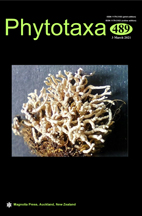Abstract
Pestalotioid species (Pestalotiopsis, Pseudopestalotiopsis and Neopestalotiopsis) cause extremely damaging diseases in a wide range of hosts across the word. Recently, pestalotioid strains isolated from damaged guarana leaf tissue were subject to morphological and molecular characterization. Six monosporic isolates were obtained and analysed based on the following conidial characters: length, width, septation, absence or presence of basal appendage, number and length of apical appendages. For phylogenetic inference, sequences of the Internal Transcribed Spacer region (ITS), partial sequences of the genes encoding the translation elongation factor 1-α (tef1-α) and β-tubulin (tub2) were used. Three out of six strains analysed were identified as Neopestalotiopsis formicarum, while the three other isolates are described here as a new species of Pseudopestalotiopsis, named Ps. gilvanii sp. nov.. The pathogenicity of N. formicarum and Ps. gilvanii were confirmed following Koch’s postulate. Besides guarana, the potential of N. formicaram and Ps. gilvanii to cause diseases in other economically important tropical plants were investigated. Ps. gilvanii was pathogenic to açaí palms (Euterpe oleracea, E. precatoria), and oil palm (Elaeis guineensis), but not to banana (Musa paradisiaca var. pacovan) and rubber trees (Hevea brasiliensis). N. formicarum was not pathogenic to rubber trees but was pathogenic to other species tested. To our knowledge this is the first report of N. formicarum as a plant pathogen in the guarana plant, and Ps. gilvanii as novel plant pathogen capable of causing disease in important plant crops from tropical regions.

